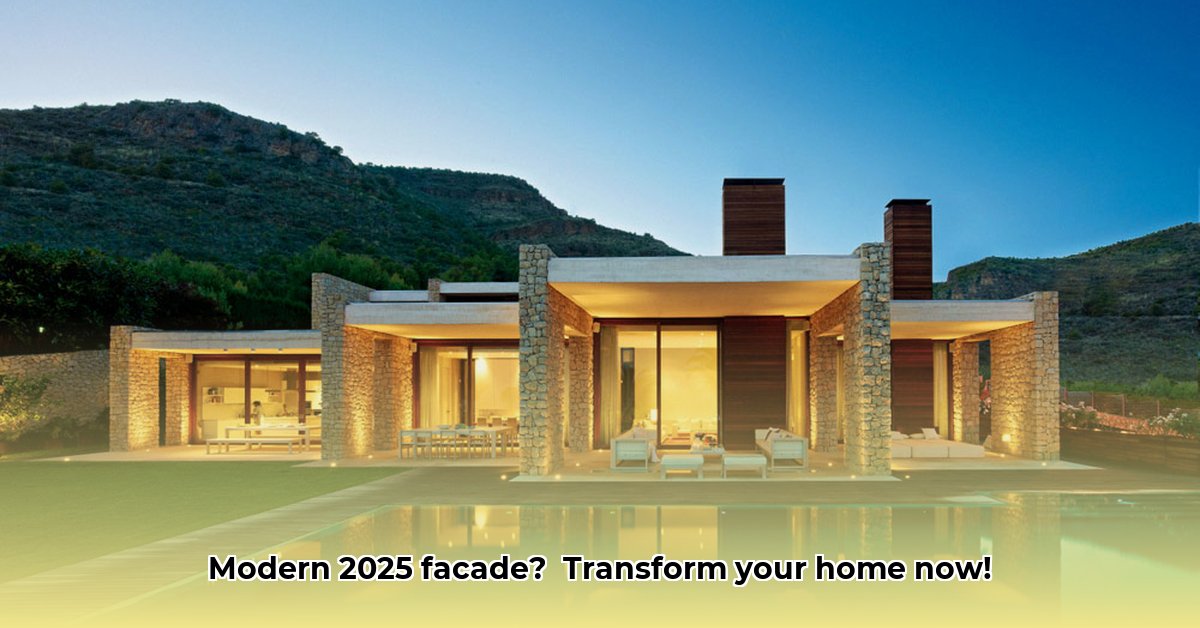Want a stunning home exterior that’s also eco-friendly and smart? This guide breaks down the hottest trends in modern house design for 2025 and beyond. We’ll show you the difference between styles like Modern Farmhouse and Miami Modern, so you can find the perfect look for your home. From choosing sustainable materials to making your home smarter, we’ll walk you through every step of the process—with practical tips and advice for homeowners, architects, and builders alike. Learn how to create a curb appeal that’s both gorgeous and long-lasting. For more design inspiration, check out this modern facade guide. Let’s get started!
Modern House Facade Home Design: 2025 Trends and Transformations
Giving your home’s exterior a fresh, modern look can dramatically improve its curb appeal and even boost its value. Let’s explore the exciting trends shaping modern home facade design in 2025.
Minimalism Meets Sustainability: A New Look for Your Home’s Exterior
The modern look continues to favor clean lines and simple shapes. Think big windows letting in tons of natural light – that’s a classic modern touch. But the big news for 2025 is sustainability. We’re seeing a huge increase in eco-friendly materials. Reclaimed wood gives a home character and a connection to the past, while recycled metal adds a cool, industrial vibe. Fiber cement is super durable and easy to maintain. Green walls are not just trendy; they improve the air quality around your home and provide habitat for local wildlife.
- Minimalist Aesthetics: The trend prioritizes clean lines, geometric shapes, and expansive windows, maximizing natural light and visual space.
- Sustainable Materials: Greater emphasis is placed on eco-friendly materials like reclaimed wood, recycled metal, and fiber cement, which reduce environmental impact.
- Smart Technology Integration: Automated lighting, smart security systems, and energy management systems are increasingly common, enhancing energy efficiency and security.
Choosing the Right Materials: Weighing Your Options
The materials you pick will make a huge difference in the final look and feel of your home’s exterior. Let’s explore some popular choices:
| Material | Pros | Cons |
|---|---|---|
| Reclaimed Wood | Unique character, environmentally friendly, warm feeling, tells a story, often locally sourced | Can be more expensive, needs regular upkeep including sealing and pest control, may have limited availability |
| Recycled Metal | Durable, modern style, sustainable, fire-resistant, excellent for reflecting heat, long lifespan | Might be pricey, needs specialized installation, can be prone to rust in coastal environments if not properly treated |
| Fiber Cement (Hardie Board) | Durable, low-maintenance, fire-resistant, resists pests and rot, versatile in appearance | Can be costly, less unique character than natural materials, requires proper sealing and painting |
| Green Walls | Beautiful, environmentally conscious, better air quality, provides habitat for beneficial insects and birds, can reduce building temperature | Higher upfront cost, requires specialized care including irrigation and pruning, can attract unwanted pests if not maintained |
| Vinyl Siding | Budget-friendly, low maintenance, many styles available, easy to install | Not as durable as other options, may not appeal to everyone aesthetically, can be susceptible to damage from extreme weather, less environmentally friendly |
Smart technology is becoming increasingly important in modern home design. Automated lighting enhances curb appeal and saves energy. Smart security systems give you peace of mind by alerting you when you need it most, monitoring conditions, and remote controlling. The key is to find the right balance—technology should enhance the design, not clash with it. Too many gadgets can make a home feel cluttered rather than sleek. Consider a smart thermostat that learns your habits and adjusts the temperature accordingly.
Architectural Styles: Finding Your Perfect Match
Several architectural styles influence modern home designs in 2025. The modern farmhouse blends rustic charm with contemporary elements, offering a cozy yet sophisticated feel. Miami Modern brings a vibrant, tropical feel, characterized by bright colors and geometric shapes. Scandinavian design emphasizes simplicity and functionality, creating a serene and uncluttered atmosphere. It’s all about choosing a style that suits your climate, lifestyle, and personal preferences. Consider the overall aesthetic you’re aiming for – perhaps something bold and dramatic, or subtle and understated.
Color Palettes and Landscaping: The Finishing Touches
Color is crucial. Neutral tones like grays, whites, and creams create a classic, elegant look that will likely last for years. But don’t be afraid to add pops of bolder color for a unique touch. For example, a bright front door can add personality to a neutral facade. Landscaping is equally important; it brings the whole design together. Using native plants helps conserve water, and strategically placed lighting enhances the curb appeal at night. Consider incorporating a rain garden to manage stormwater runoff. The right color choices and landscaping details can transform a house from ordinary to extraordinary. Think carefully about creating a cohesive look.
A Step-by-Step Guide for Homeowners: Turning Your Vision into Reality
Transforming your home’s exterior is exciting, but it requires careful planning. Follow these steps for a smooth process:
- Research and Inspiration: Dive into magazines, websites, and social media; gather plenty of ideas. Create a mood board to visualize your desired aesthetic.
- Consult with Professionals: Talk to architects, designers, and contractors to explore possibilities and get expert advice. Get multiple quotes to compare pricing and services.
- Budgeting: Create a realistic budget and prioritize features. You might discover that some sustainable options, while initially more expensive, can save money in the long run through reduced energy costs. Include a contingency fund for unexpected expenses.
- Material Selection: Choose durable, sustainable materials that align with your style and budget. Consider the local climate and environmental conditions.
- Detailed Planning: Work closely with your professionals to finalize detailed plans and specifications. Ensure all details, including dimensions and finishes, are clearly documented.
- Permits and Approvals: Obtain all necessary building permits before starting construction. Research local building codes and regulations.
- Construction Oversight: Keep a close eye on the construction process to ensure everything proceeds as planned. Regularly communicate with the construction team to address any issues promptly.
For Professionals: Staying Ahead of the Curve
Architects, builders, and contractors need to actively stay on top of the latest trends. Embrace sustainable practices; they’re not just environmentally responsible, but they also appeal to a growing number of environmentally conscious clients. Become proficient in building information modeling (BIM) software. It’s also crucial to master smart home technology. By offering clients cost-effective, eco-friendly options, you position yourself as a leader in the field. Investing in training will be key to remaining competitive in this ever-evolving field. Attend industry conferences and workshops to stay updated on the latest innovations.
Want to create an amazing modern home facade? Let’s start with your style and the kind of materials you love. Transforming your home’s exterior starts with a clear vision. Remember, there are many different styles and approaches, some experts suggest focusing on a specific design concept first, then selecting the materials accordingly. Ongoing research in sustainable building materials might lead to even more innovative solutions in the future.
How to Compare Costs of Sustainable vs. Traditional Modern Home Exterior Materials
Key Takeaways:
- Upfront costs for sustainable materials are typically higher than traditional options. However, long-term savings from energy efficiency and reduced maintenance often outweigh initial expenses.
- Environmental benefits of sustainable materials are significant, reducing your carbon footprint and promoting resource conservation.
- The choice between sustainable and traditional materials impacts the entire lifecycle, from manufacturing and installation to eventual disposal.
Modern Facade Trends: A Balancing Act
2025 modern home facades showcase a beautiful blend of aesthetics and sustainability. Think sleek lines, geometric shapes, and expansive windows—the classic modern aesthetic. But now, we’re seeing a conscious shift towards eco-friendly materials. Want a gorgeous home and a smaller environmental footprint? It’s totally achievable.
Exploring Material Choices: Sustainable vs. Traditional
Let’s dive into some popular exterior materials. How do you compare costs of sustainable vs traditional modern home exterior materials? It involves careful consideration of both initial investment and long-term expenses.
| Material | Type | Initial Cost | Long-Term Cost (Maintenance, Energy Savings) | Environmental Impact |
|---|---|---|---|---|
| Reclaimed Wood | Sustainable | High | Moderate (low maintenance, potential rot if not properly sealed) | Low (reduced deforestation, diverts waste from landfills) |
| Recycled Metal Cladding | Sustainable | High | Low (very durable, low maintenance, resists pests and fire) | Low (reduced mining impact, less energy consumption in production) |
| Fiber Cement Siding | Sustainable | Moderate | Moderate (durable, low maintenance, resists pests) | Moderate (manufacturing process involves some energy consumption) |
| Concrete | Traditional | Moderate | Moderate (high durability, but can crack, requires sealing) | High (cement production is carbon-intensive, contributes |
- Glass Tile Shower Ideas to Create a Stunning Bathroom Space - December 7, 2025
- Glass Wall Tile Ideas for Kitchens and Bathrooms - December 6, 2025
- Glass Tile Bathroom: Create a Beautiful, Easy-Clean Space - December 5, 2025










